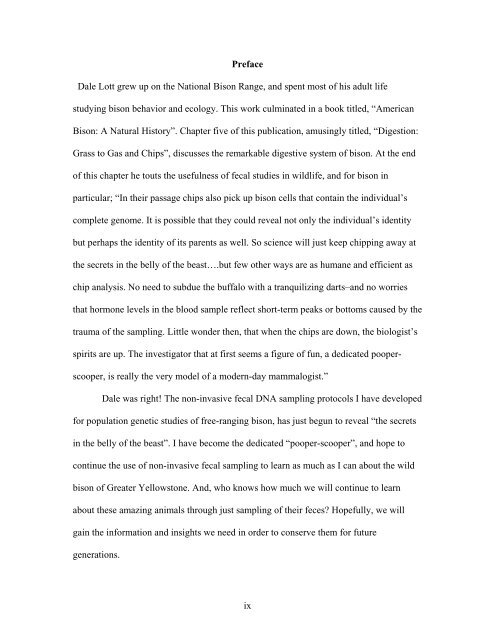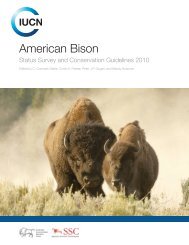Declaration Dr. Thomas H. Pringle - Buffalo Field Campaign
Declaration Dr. Thomas H. Pringle - Buffalo Field Campaign
Declaration Dr. Thomas H. Pringle - Buffalo Field Campaign
You also want an ePaper? Increase the reach of your titles
YUMPU automatically turns print PDFs into web optimized ePapers that Google loves.
Preface<br />
Dale Lott grew up on the National Bison Range, and spent most of his adult life<br />
studying bison behavior and ecology. This work culminated in a book titled, “American<br />
Bison: A Natural History”. Chapter five of this publication, amusingly titled, “Digestion:<br />
Grass to Gas and Chips”, discusses the remarkable digestive system of bison. At the end<br />
of this chapter he touts the usefulness of fecal studies in wildlife, and for bison in<br />
particular; “In their passage chips also pick up bison cells that contain the individual’s<br />
complete genome. It is possible that they could reveal not only the individual’s identity<br />
but perhaps the identity of its parents as well. So science will just keep chipping away at<br />
the secrets in the belly of the beast….but few other ways are as humane and efficient as<br />
chip analysis. No need to subdue the buffalo with a tranquilizing darts–and no worries<br />
that hormone levels in the blood sample reflect short-term peaks or bottoms caused by the<br />
trauma of the sampling. Little wonder then, that when the chips are down, the biologist’s<br />
spirits are up. The investigator that at first seems a figure of fun, a dedicated pooper-<br />
scooper, is really the very model of a modern-day mammalogist.”<br />
Dale was right! The non-invasive fecal DNA sampling protocols I have developed<br />
for population genetic studies of free-ranging bison, has just begun to reveal “the secrets<br />
in the belly of the beast”. I have become the dedicated “pooper-scooper”, and hope to<br />
continue the use of non-invasive fecal sampling to learn as much as I can about the wild<br />
bison of Greater Yellowstone. And, who knows how much we will continue to learn<br />
about these amazing animals through just sampling of their feces? Hopefully, we will<br />
gain the information and insights we need in order to conserve them for future<br />
generations.<br />
ix










